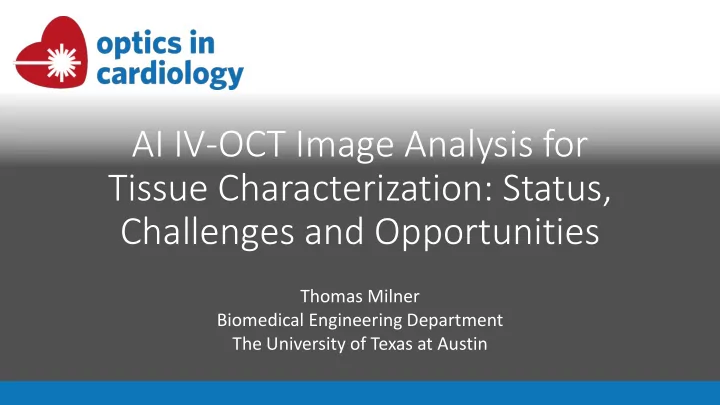

AI IV-OCT Image Analysis for Tissue Characterization: Status, Challenges and Opportunities Thomas Milner Biomedical Engineering Department The University of Texas at Austin
Yin-and-Yang of AI IV-OCT Tissue Classification Yang Yin Mostly Unknown Mostly Known AI Neural Network
Why AI I IV IV-OCT Tissue Classification? Yang Yin • Training Tool • Second Opinion • IVOCT Knowledge Mostly Registry Unknown Inexperienced IV-OCT Mostly Known Expert IV-OCT Users/Readers Expert IV-OCT Users Users/Readers FEW MANY
Motivation: VH IV IVUS Clinical Trial Enrollment VH IVUS Introduced • Before VH-IVUS: 550 people/year • After VH-IVUS: 1800 people for year Before After VH-IVUS VH-IVUS
Neural Network Development Work-Flow IV-OCT Imaging
Status: Texas Human Heart Data Library ry • 42 human hearts collected • 79 arteries imaged • 63 arteries processed with histology • Histopathological analysis conducted in collaboration with Deborah Vela, M.D. and L. Maximilian Buja, M.D. at the Texas Heart Institute, Cardiovascular Pathology Department • 54 arteries co-registered to OCT • 3229 histology sections matched to OCT frames • Corresponding OCT frames encompass approximately 300 million data points • 54 arteries fully tabulated to 8 plaque types
IV IV-OCT Im Imaging • Hearts from 28 men and 14 women, average age at death 56 +/- 10 years • St Jude Illumien: 56 arteries (28 LAD, 28 RCA) • Volcano CorVue: 20 arteries (10 LAD, 10 RCA) Arteries/Cases Pixels A-Scans Training 28 1.5 million 100,800 Testing 28 1.5 million 100,800 TCFA 17 N/A N/A
Feature and Node Optimized Neural Networks Network Architecture Optimization Feature Selection 100 95 90 100 85 95 80 90 75 85 70 80 65 75 70 Lipid Optimized Lipid Optimized Fibrous Calcium Fibrous Optimized Calcium Optimized Features Architecture Optimized Optimized Features Features Architecture Architecture Lipid Accuracy Fibrous Accuracy Calcium Accuracy Lipid Accuracy Fibrous Accuracy Calcium Acuracy Features and network architecture must be tailored for tissue type for highest accuracy Solution: Multiple independently-optimized neural nets are used. Feature And Node Optimized Neural Nets (FANONN)
Feature Ext xtraction Statistical GLCM • Contrast • Mean Value • Energy • Variance • Correlation • Skewness • Homogeneity • Kurtosis • Entropy • • Max Probability Energy A-Scan Analysis • Attenuation
Feature and Node Optimized Neural Networks
Multi-Layer Neural Network Performance • Virtual Histology-OCT neural network classifier was tasked to Thin cap fibroatheroma colorize entire B-scans • Three clinically relevant pathological plaque conditions were evaluated • Neural network colorizations Fibrocalcific match histology plaque Tissue Type Sensitivity Specificity Thick cap fibroatheroma Fibrous 87% 80% Fibrous Calcium 85% 87% Calcium Lipid 86% 80% Lipid TCFA 82% 76% OCT Histology Guided Expert Neural Network Histology Samples 5L, 4L, 4R Demarcation Colorization Sc Scal ale bar bars s 1 1 mm
Macrophage Neural Network Layer
Expanded Tissue Categories Scale bars 1 mm
Next xt-Genration Neural Networks • Sequential samplings/convolutions for automatic feature generation • U-nets for rapid pixel classification
Challenge: Resource Requirements Source of Human Hearts Histopathology/Registration Network Optimization Time
Challenge/Opportunity: : Next xtGen In Instrumentation Existing Instrument Next Generation • PS-OCT • Minimize Requirements for Retraining? • PT OCT . • Downward-compatible instrument- . independent neural networks? .
1210nm Photothermal (P (PT) IV IV-OCT • Lipid has distinct absorption at 1210nm • Photothermal Contrast detect arterial lipid 500µm • Tested successfully on 3 arteries • Needs to be integrated into classification workflow
Opportunities • Better Patient Outcomes • Increased IVOCT use • Enable and empower better therapies • Hybrid opto-electronic computing technologies
Summary ry and Conclusions • Multilayer histology-validated neural networks constructed and tested to detect fibrous, lipid, calcium and plaque type • Sensitivity and specificity for fibrous, lipid, and calcium tested on non- trained hearts is 80-87% • Each tissue type requires an individualized feature and node optimized neural network • Approaches needed to develop downward compatible instrument- independent neural nets for next-generation IVOCT imaging instrumentation • Opportunities to provide better patient outcomes to PCI
University of Texas at Austin Texas Heart Institute Vikram Baruah, BSc Deborah Vela, MD Aydin Zahedivash, BS, MD Maximilian Buja, MD Austin McElroy, BSc Arnold Estrada, PhD UT Health Sciences Center San Antonio Taylor Hoyt, BSc Piotr Antonik, PhD Andrew Cabe, BSc Meagan Oglesby, BSc Marc Feldman, MD
Recommend
More recommend